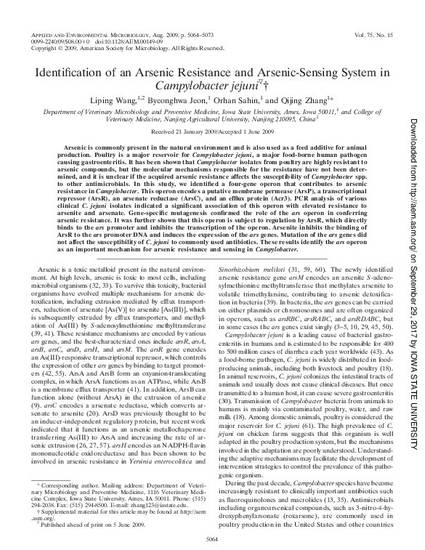
Arsenic is commonly present in the natural environment and is also used as a feed additive for animal production. Poultry is a major reservoir for Campylobacter jejuni, a major food-borne human pathogen causing gastroenteritis. It has been shown that Campylobacter isolates from poultry are highly resistant to arsenic compounds, but the molecular mechanisms responsible for the resistance have not been determined, and it is unclear if the acquired arsenic resistance affects the susceptibility of Campylobacter spp. to other antimicrobials. In this study, we identified a four-gene operon that contributes to arsenic resistance in Campylobacter. This operon encodes a putative membrane permease (ArsP), a transcriptional repressor (ArsR), an arsenate reductase (ArsC), and an efflux protein (Acr3). PCR analysis of various clinical C. jejuni isolates indicated a significant association of this operon with elevated resistance to arsenite and arsenate. Gene-specific mutagenesis confirmed the role of the ars operon in conferring arsenic resistance. It was further shown that this operon is subject to regulation by ArsR, which directly binds to the ars promoter and inhibits the transcription of the operon. Arsenite inhibits the binding of ArsR to the ars promoter DNA and induces the expression of the ars genes. Mutation of the ars genes did not affect the susceptibility of C. jejuni to commonly used antibiotics. These results identify the ars operon as an important mechanism for arsenic resistance and sensing in Campylobacter.
Available at: http://works.bepress.com/qijing-zhang/57/

This article is published as Wang, Liping, Byeonghwa Jeon, Orhan Sahin, and Qijing Zhang. "Identification of an arsenic resistance and arsenic-sensing system in Campylobacter jejuni." Applied and environmental microbiology 75, no. 15 (2009): 5064-5073. doi: 10.1128/AEM.00149-09. Posted with permission.